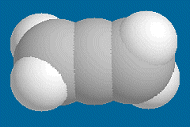 |
| Introduction |
| Symmetry Elements |
| · Proper Rotation Axis |
| · Mirror Plane |
| · Inversion Centre |
| · Improper Rotation Axis |
| · Identity |
| Point Group Gallery |
| Spotting a Chiral Compound |
| · Part I - Mirror Planes |
| · Part II - Inversion Centre |
| · Part III - Improper Rotation |
| · Summary & Conclusion |
| WSM Homepage |
Molecular Symmetry and Chirality
How to Spot a Chiral Compound
Note: viewing the structures on these pages requires use of
the MDL Chime Plug-In.
| Part I - Mirror Planes | [Part II] [Part III] [Summary] |
I thought that it was about four bonds to carbon! We were told that if a molecule had a C atom with four different groups, the molecule was chiral!
Yeah, your mom told you Santa Claus was real, too.
The four different groups thing is a good trick, but it's obviously only useful for organic compounds, and even then it doesn't always work. Four different groups at a C atom -- a so-called stereogenic carbon or stereocentre -- is neither a necessary nor sufficient condition for chirality. In other words: A) chirality can occur in the absence of such carbon, and B) the presence of such a carbon isn't a guarantee for chirality.
Case A: chirality in the absence of a stereogenic carbon.
None of the structures below has four different groups at any carbon. In fact, none has four bonds at any carbon: all the C atoms are sp2 hybridized. The compounds at left are helicenes, complexes that consist of helical spirals of aromatic rings. The resulting corkscrew shape means that the clockwise and anti-clockwise spirals are non-superimposable mirror images. The compounds at right are coordination compounds, in which three bidentate bipyridine ligands form a pinwheel. Again, the pinwheel can either be clockwise or anti-clockwise, so the two compounds are enantiomers.
Case B: no chirality in the presence of a stereogenic carbon.
Compounds with multiple stereocentres can remain achiral if pairs of stereocentres cancel each other out. Below are various isomers of 2,3-dibromobutane, where in each case there are two C atoms connected to four different groups: -H, -CH3, -Br, and -CH(Br)CH3. Two of the isomers are enantiomers -- the (R,R) and (S,S) are non-superimposable mirror images. However, the (R,S) isomer is identical to its mirror image -- it is not chiral, despite the presence of two potential stereocentres. Because the two stereocentres are mirrors of each other, the potential chirality of the molecule as a whole is negated.
| (R,R)-2,3-dibromobutane | (S,S)-2,3-dibromobutane | (R,S)-2,3-dibromobutane | |
| RR and SS are enantiomers | RS is its own mirror: achiral! | ||
The trouble is that chirality is a molecular property, not an atomic one. Atoms aren't chiral, and the bonds at a single atom don't determine chirality. The geometry and symmetry of the entire molecule must be considered. A common feature of the compounds above is this: the chiral compounds lack a mirror plane of symmetry, while the achiral isomer possesses one, as seen is clearer in the fully eclipsed conformation shown at right. A compound with multiple stereocentres that remains achiral due to an internal mirror plane is called a meso compound (from Greek meso = middle). If a molecule has a mirror plane, then its mirror image must be identical, so it isn't chiral; if a molecule lacks the mirror plane, the mirror image must be different, so the two compounds are enantiomers. |
So, forget four groups at carbon. The real test is the absence of a mirror plane.
Mirror plane = not chiral, no mirror plane = chiral.
Almost. More than 99% of the time, that will be true. But it's not always the case, as we see in Part II.
This page is maintained and copyright by W. Stephen McNeil at UBC Okanagan.
.